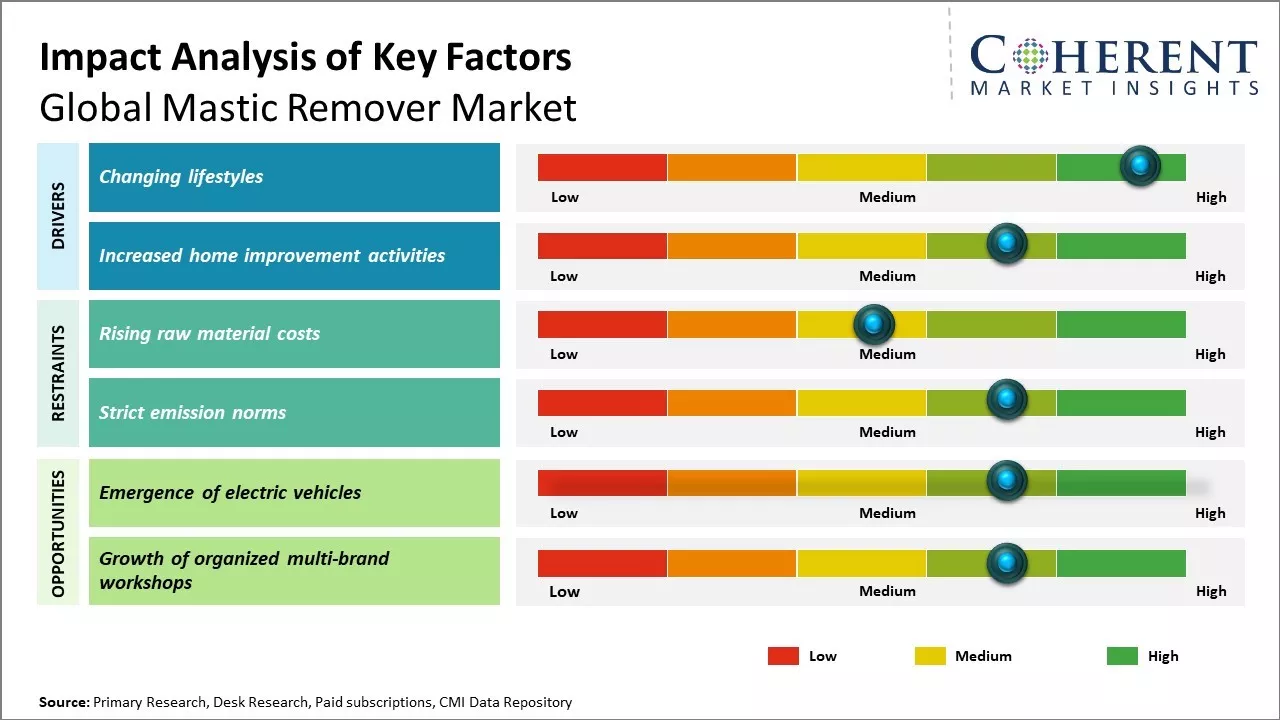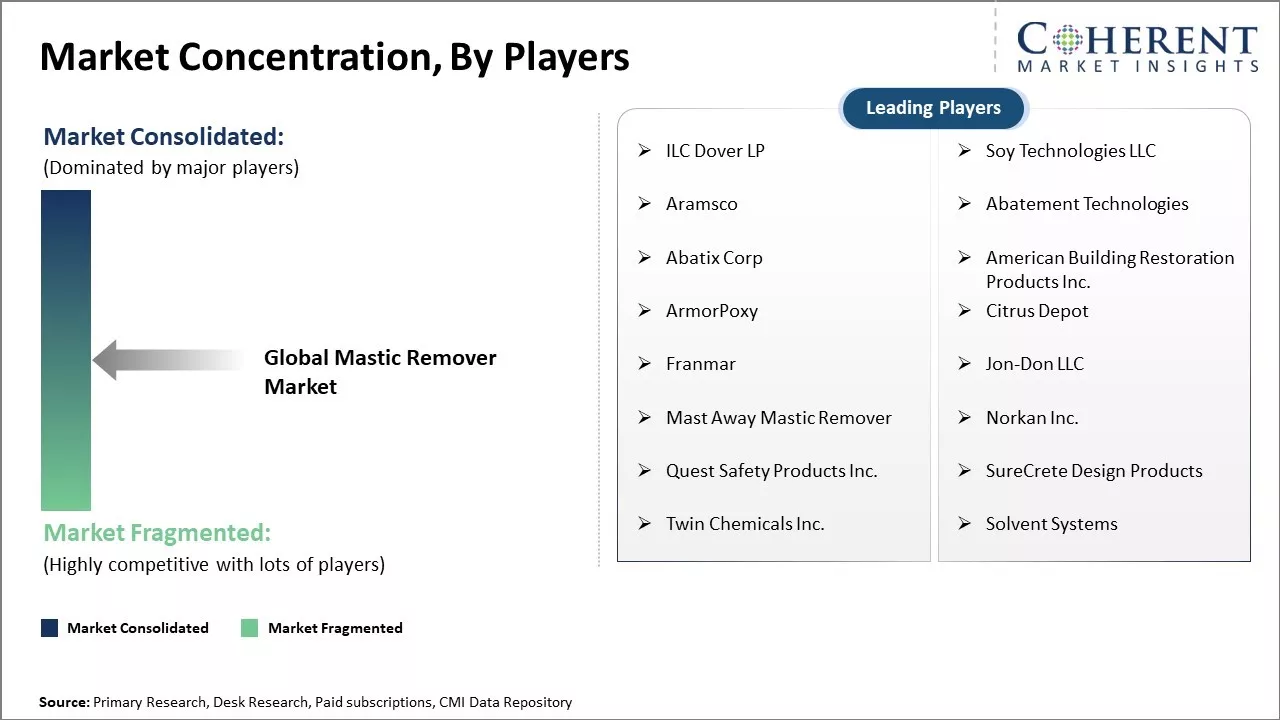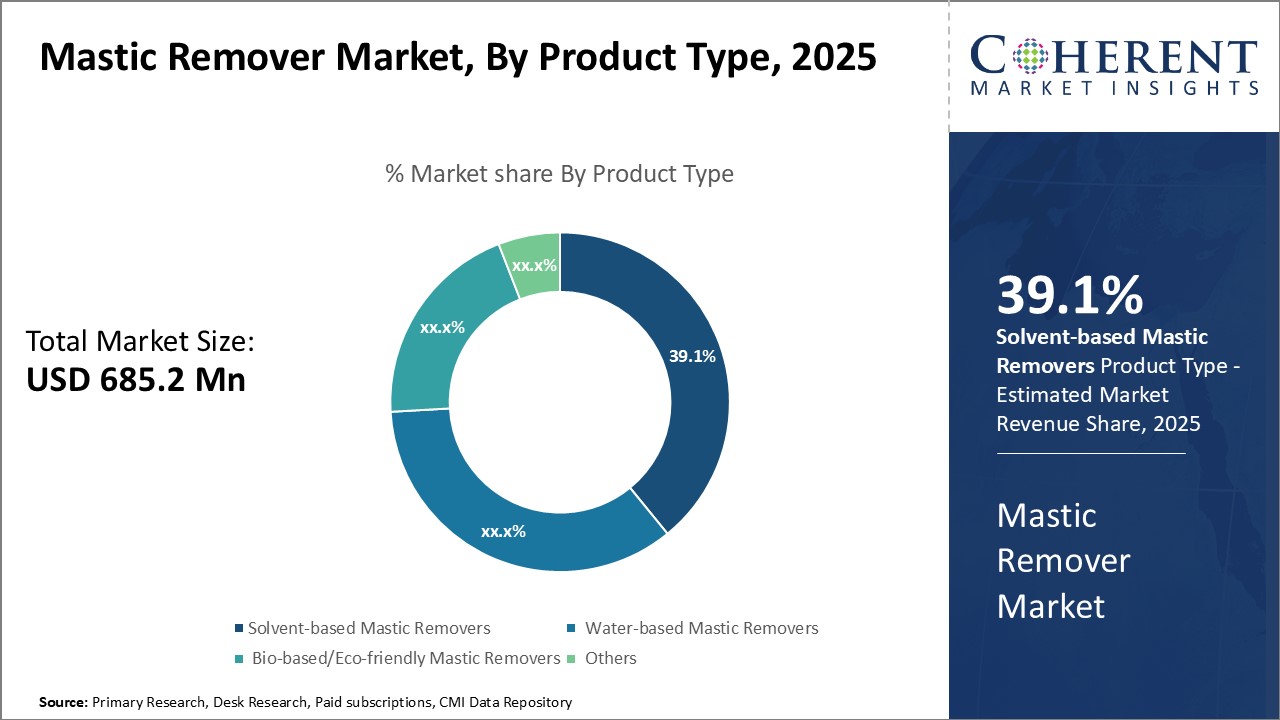Mastic Remover Market Size and Trends
The mastic remover market is estimated to be valued at USD 685.2 Mn in 2025 and is expected to reach USD 1,079.6 Mn by 2032, exhibiting a compound annual growth rate (CAGR) of 6.7% from 2025 to 2032.

Discover market dynamics shaping the industry: Download Free Sample
The construction industry has seen steady growth over the past few years and the demand for mastic removers is expected to increase due to their use in removing old mastic during renovation and remodeling activities. The market is driven by the rising number of renovation and remodeling activities across both the residential and commercial sectors. Mastic removers help smoothen the surface and make it suitable for laying new flooring which is driving its increased adoption. However, stringent environmental regulations regarding VOC emissions from these products might restrict market growth to some extent over the forecast period.
Drivers of the Market:
Changing lifestyles
With the rise in dual-income households and busy lifestyles, consumers are looking for quick solutions to perform household chores in minimum time. Mastic remover products have become popular as they allow users to remove old mastic and tiles in a matter of hours without putting in extensive physical labor. Earlier, removing mastic used to be a tedious weekend job requiring scraping and scrubbing. However, the new generation of chemical-based removers has transformed this task into a simple process. Users just need to apply the liquid product, let it sit for some time and then scrape off the dissolved mastic easily.
This convenience offered by mastic removers fits well with the fast-paced lifestyle of modern consumers. People no longer want to spend their limited free time on strenuous cleaning chores and look for easy and hassle-free solutions. Working professionals with little free time on weekends especially find great value in mastic removers. They can do the removal work on a Saturday or Sunday and be done with it within half a day instead of toiling over it for the entire weekend. Young mobile homeowners are another consumer group rapidly adopting mastic removers as it allows them to do small repair or renovation tasks independently without depending on labor help.
Market Concentration and Competitive Landscape

Get actionable strategies to beat competition: Download Free Sample
Increased home improvement activities
The home improvement industry has been experiencing steady growth over the past few years with more consumers spending on renovating and repairing their homes. Various factors are attributed to this surge, including improving economic conditions and rising incomes. After facing job losses or pay cuts during the economic slowdown, consumer confidence is back along with spending power. With more disposable income, homeowners are undertaking deferred maintenance work or enhancing their living spaces to increase resale value.
Key Takeaways from Analyst:
One of the key drivers for growth is the increasing home remodeling and renovation activities globally. As more homeowners look to update their kitchens and bathrooms, the demand for mastic removers will rise. Another factor aiding demand is the need for the periodic maintenance of commercial and industrial structures built decades ago when mastic-based adhesives were commonly used.
Certain factors may restrain the market's growth. Stringent environmental regulations regarding the use of toxic chemicals in remover formulations pose a challenge for manufacturers. Products will need to move toward more eco-friendly compositions. Availability of alternative removal methods like scraping and heat guns can also impact sales to some extent.
The North America region currently dominates the mastic remover sales given the high remodeling frequency in countries like the U.S. Europe is also a major market boosted by renovation of older buildings. However, emerging economies of Asia Pacific are expected to provide new opportunities for market players. With improving economic conditions and increasing homeownership rates, the demand for mastic removers is seen rising steadily in countries like India and China.
Challenges: Rising raw material costs
Rising raw material costs is proving to be a major challenge for the growth of the mastic remover market. Mastic removers are primarily composed of chemicals and solvents which are petroleum-based derivatives. Over the past year, a significant rise in oil and gas prices due to supply chain disruptions caused by the COVID-19 pandemic and geopolitical tensions. Russia's invasion of Ukraine has further exacerbated these issues and pushed commodity prices to record highs.
Opportunities: Emergence of electric vehicles
The emergence of electric vehicles presents a great opportunity for the mastic remover market to grow substantially in the coming years. As electric vehicles continue to gain wider acceptance and market share globally, the need to remove old mastic during installations of newer charging stations will rise significantly. Currently, mastic is used at commercial locations like parking lots as an adhesive to hold wiring and other equipment in place. As countries around the world look to expand their electric vehicle charging infrastructure via installing thousands of new charging points each year, it often requires the removal of existing mastic substrates.

Discover high revenue pocket segments and roadmap to it: Download Free Sample
Insights by product type: Convenience and effectiveness drive the demand for solvent-based mastic removers
In terms of product type, solvent-based mastic removers is expected to contribute 39.1% share of the market in 2025, owing to their convenience and effectiveness in removing a variety of mastics and adhesives. Solvent-based removers are capable of quickly dissolving and lifting off even the most stubborn mastics and glues, saving contractors and DIY users significant time and effort during renovation and flooring replacement projects. Their liquid formulation allows them to be easily applied with a paintbrush or roller to coat target surfaces uniformly. Once the solvent penetrates the mastic or adhesive layer, it typically takes only a few hours for the material to soften enough to be scraped off cleanly. The evaporation of the solvent carrier afterwards leaves surfaces dry and ready for subsequent preparations without any residue. The speed and thorough cleaning ability of solvent-based removers have made them the top choice among professional tradesman seeking maximum productivity. Their performance edge over alternative products continues supporting demand from both the commercial and residential end-users.
Insights by application: Convenience of use boosts the adhesive removal segment
In terms of application, adhesive removal is expected to contribute 32.7% share of the market in 2025, owing to the convenience that mastic removers provide this application. Whether removing sticky labels and tapes or dismantling glued assemblies, mastic removers have become invaluable aids for adhesive removal tasks of all kinds. Their ability to quickly break down the chemical bond between adhesive and adherend surface through targeted solvent action cuts down processing time significantly. This allows complex disassembly, remodeling or renovation projects involving adhesives to progress much more efficiently. The non-abrasive characteristics of mastic removers also help prevent scuffing or damage to surrounding substrates compared to mechanical scraping. As moredo-it-yourself (DIY) tasks involve adhesive components, the adhesive removal segment continues growing in importance thanks to the convenience mastic removers offer frustrated users.
Insights by distribution channel: Hardware stores optimize access and selection for customers
In terms of distribution channel, hardware stores is expected to contribute 40.6% share of the market in 2025, owing to their focus on optimizing access and product selection for customers. As universal one-stop shops carrying all manner of building and maintenance supplies, hardware stores aim to fully serve the varied needs of contractors, tradespeople as well as everyday DIYers and homeowners. Their extensive shelving space devotes sizable areas to mastic remover displays so that different product types from various brands can be easily examined and compared. Knowledgeable staff are also on hand to recommend the best solution matching each customer’s specific job requirements and budgets. As community fixtures, their convenient storefront locations in both urban and rural localities maximize product accessibility. Hardware stores’ wide choices and extensive support attract buyers who prefer solid product guidance or simply want fast solutions for impromptu projects. This dedicated service continues giving hardware stores an edge over alternatives in serving the diverse and evolving mastic remover market.
Regional Insights

Need a Different Region or Segment? Download Free Sample
North America has been dominating the global mastic remover market for a long time owing to strong paints and coatings industry presence in the U.S. and Canada. The region is expected to account for 34.9% of the market share in 2025. The paints industry in North America is highly organized with the presence of global as well as domestic players. Furthermore, the high disposable incomes and purchasing power of homeowners in the region encourage them to frequently refurbish and redecorate their homes, which drives the need for mastic removers. Stringent environmental regulations regarding the use of toxic materials and availability of alternatives also boost the demand for mastic removers in North America instead of harsh chemicals. The import and export of mastic removers is well established in North America with the U.S. being the key importer.
The Asia Pacific region, especially China and India, has emerged as the fastest growing market for mastic removers in recent years. This can be attributed to the surge in infrastructure development activities taking place across major economies. Rapid urbanization has substantially increased residential and commercial construction, requiring the removal of existing materials for renovation purposes. Additionally, growth in the manufacturing and industrial sectors have led to expansion and upgrades of existing facilities. This has created a huge demand for mastic removers in the industrial maintenance, repair and operations (MRO) activities in the region. The pricing of mastic removers is also comparatively lower in the Asia Pacific market owing to ease of availability of raw materials and lower manufacturing costs. However, uneven enforcement of environmental regulations in some countries poses challenges for industry players regarding use of certain ingredients.
Market Report Scope
Mastic Remover Market Report Coverage
| Report Coverage | Details | ||
|---|---|---|---|
| Base Year: | 2024 | Market Size in 2025: | USD 685.2 Mn |
| Historical Data for: | 2020 To 2024 | Forecast Period: | 2025 To 2032 |
| Forecast Period 2025 to 2032 CAGR: | 6.7% | 2032 Value Projection: | USD 1,079.6 Mn |
| Geographies covered: |
|
||
| Segments covered: |
|
||
| Companies covered: |
ILC Dover LP, Soy Technologies LLC, Aramsco, Abatement Technologies, Abatix Corp, American Building Restoration Products Inc., ArmorPoxy, Citrus Depot, Franmar, Jon-Don LLC, Mast Away Mastic Remover, Norkan Inc., Quest Safety Products Inc., SureCrete Design Products, Twin Chemicals Inc., and Solvent Systems |
||
| Growth Drivers: |
|
||
| Restraints & Challenges: |
|
||
Uncover macros and micros vetted on 75+ parameters: Get instant access to report
Mastic Remover Industry News
- In 2023, DuPont launched a higher-adhesion, low-cyclics silicone soft skin adhesive
*Definition: The mastic remover market provides products that are used to remove mastic adhesives from surfaces before installing new flooring. Mastic removers soften and dissolve mastic adhesive residues so they can be easily scraped away from floors, eliminating the need for harsh chemicals or mechanical scraping that could damage flooring. Common mastic remover products include liquids, gels and pastes that are applied to mastic adhesive residues, given time to work, then scrapable away. The global mastic remover market offers a variety of effective and safe remover options for commercial and residential flooring installation and renovation projects.
Market Segmentation
- Product Type Insights (Revenue, USD Mn, 2020 - 2032)
- Solvent-based Mastic Removers
- Water-based Mastic Removers
- Bio-based/Eco-friendly Mastic Removers
- Others
- Application Insights (Revenue, USD Mn, 2020 - 2032)
- Tile Removal
- Carpet Removal
- Vinyl Flooring Removal
- Adhesive Removal
- Distribution Channel Insights (Revenue, USD Mn, 2020 - 2032)
- Hardware Stores
- Home Improvement Centers
- Online Retailers
- Specialty Stores
- Regional Insights (Revenue, USD Mn, 2020 - 2032)
- North America
- U.S.
- Canada
- Latin America
- Brazil
- Argentina
- Mexico
- Rest of Latin America
- Europe
- Germany
- U.K.
- Spain
- France
- Italy
- Russia
- Rest of Europe
- Asia Pacific
- China
- India
- Japan
- Australia
- South Korea
- ASEAN
- Rest of Asia Pacific
- Middle East & Africa
- GCC Countries
- Israel
- Rest of Middle East & Africa
- North America
- Key Players Insights
- ILC Dover LP
- Soy Technologies LLC
- Aramsco
- Abatement Technologies
- Abatix Corp
- American Building Restoration Products Inc.
- ArmorPoxy
- Citrus Depot
- Franmar
- Jon-Don LLC
- Mast Away Mastic Remover
- Norkan Inc.
- Quest Safety Products Inc.
- SureCrete Design Products
- Twin Chemicals Inc.
- Solvent Systems
Share
Share
About Author
Yash Doshi is a Senior Management Consultant. He has 12+ years of experience in conducting research and handling consulting projects across verticals in APAC, EMEA, and the Americas.
He brings strong acumen in helping chemical companies navigate complex challenges and identify growth opportunities. He has deep expertise across the chemicals value chain, including commodity, specialty and fine chemicals, plastics and polymers, and petrochemicals. Yash is a sought-after speaker at industry conferences and contributes to various publications on topics related commodity, specialty and fine chemicals, plastics and polymers, and petrochemicals.
Missing comfort of reading report in your local language? Find your preferred language :
Transform your Strategy with Exclusive Trending Reports :
Frequently Asked Questions
EXISTING CLIENTELE
Joining thousands of companies around the world committed to making the Excellent Business Solutions.
View All Our Clients
